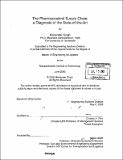The pharmaceutical supply chain : a diagnosis of the state-of-the-art
Author(s)
Singh, Mahender Pal, 1965-
DownloadFull printable version (19.70Mb)
Other Contributors
Massachusetts Institute of Technology. Engineering Systems Division.
Advisor
Charles H. Fine.
Terms of use
Metadata
Show full item recordAbstract
This study explores the current supply chain trends in the pharmaceutical industry. The main objective of the study is to characterize the pharmaceutical industry and identify excellent supply chain practices. Indeed, the pharmaceutical industry is not renowned for its supply chain management capabilities, unlike many other highly publicized industries that have profitably exploited their supply chains. It is, thus, an interesting topic for research. A closer look, however, reveals that our initial assessment of the industry is colored by the popular financial criteria prevalent among analysts and the investing public. This research will suggest that the pharmaceutical industry does care about its supply chain, although, a reevaluation of the supply chain strategy is necessary for addressing problems effectively. In fact, we will argue that an excellent supply chain is paramount to the pharmaceutical industry's success. We subscribe to the view that a supply chain should be considered excellent if it is able to effectively support a business strategy. The business objectives of the pharmaceutical industry include the need to ensure that the drugs are protected from adulteration and counterfeiting, removed and destroyed in a safe and environmentally friendly manner, and made available to patients at all time. Clearly, these are not commonly used metrics to assess the performance of a company or a supply chain. (cont.) Instead, characteristics that have direct impact on the short term financial well being of the company, such as reduced lead times, increased flexibility, and lower cost are the ones that take precedence. As a result, there is a huge gap between the actual and perceived capabilities of the pharmaceutical supply chains. Furthermore, there are clear indications that a radical transformation of the pharmaceutical industry is on the horizon which will require further strengthening of its supply chains, rendering it even more critical to success.
Description
Thesis (M. Eng. in Logistics)--Massachusetts Institute of Technology, Engineering Systems Division, 2005. Includes bibliographical references (leaves 148-150).
Date issued
2005Department
Massachusetts Institute of Technology. Engineering Systems DivisionPublisher
Massachusetts Institute of Technology
Keywords
Engineering Systems Division.